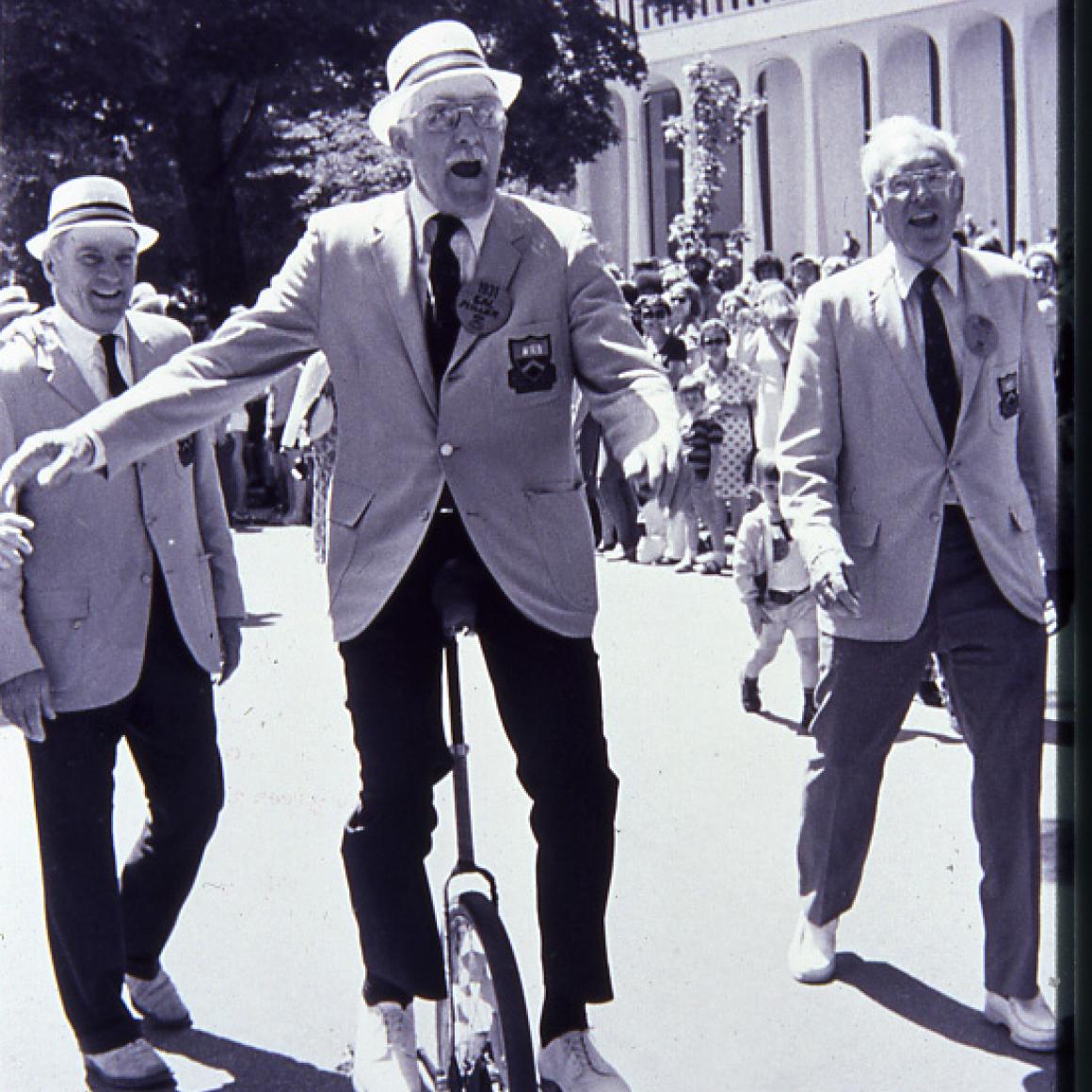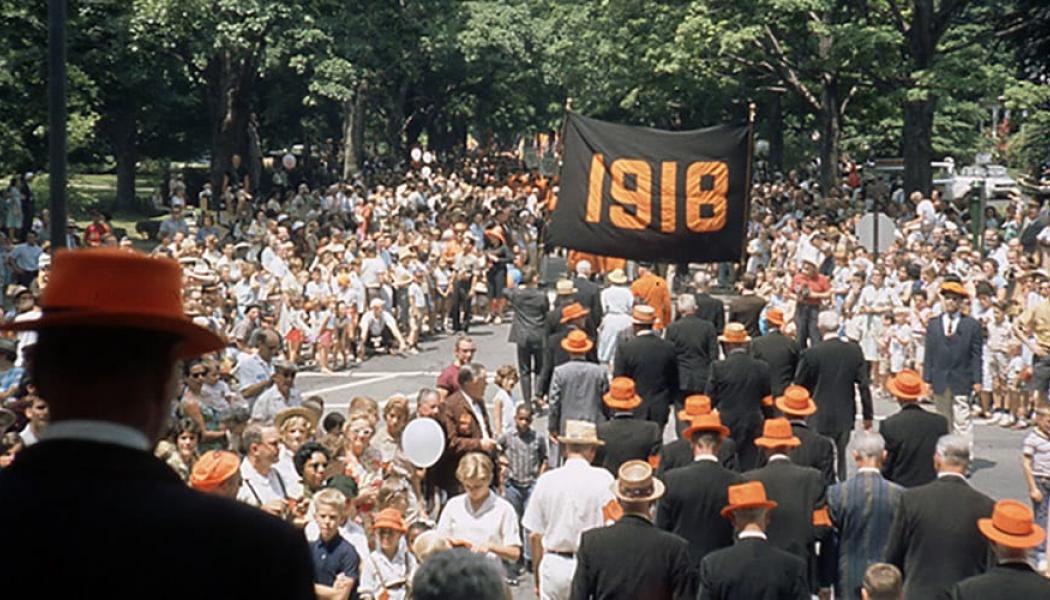Princeton’s P-rade is so much a part of University identity that many alumni may think it goes back to the founding of Old Nassau itself. That is not the case at all, as a recounting of the venerable tradition below reveals.
Commencement was the big draw for Princeton’s first 100 years. As the alumni body grew, so did the ways to celebrate, with Locomotive cheers, 25th Reunion jackets, and fireworks. Rain couldn’t dampen the enthusiasm, nor 17-year cicadas out-sing the merriment (due again this year) — not even an international pandemic could hold back burst of orange and black.
What is clear in a reading of P-rade history is that Princetonians cherish reviving their connections with the University and each other — and will find a way to make that happen no matter the circumstances.
In the College of New Jersey’s early years, alumni regularly returned to campus to attend Commencement exercises. Its 100th Commencement in June 1847 drew an impressive 700 graduates for a formal dinner, escalating the tradition into a larger event. Until 1859, all alumni gathered together, but in that year, Alfred Woodhull, Class of 1856, organized the first “class” reunion, a triennial. He astutely surmised that reasonable attendance could be expected, because in that era, anyone who returned to campus for Commencement three years after graduation qualified for an automatic master’s degree (a practice lasting until 1892).
In 1861, a regiment bound for battle in the Civil War passing through Princeton captivated the College’s students with its “skyrocket” cheer, which imitated the sound of fireworks — “sis” for the zooming rocket; “boom” for the explosion; and “ahhhh” as the crowd expressed its pleasure for the resulting light show. At Princeton, the “sis, boom, ah” skyrocket cheer evolved into Princeton’s “locomotive,” where word repetition and increasing speed emulate the sound of a train pulling out from a station. “Tiger” was likely added to the cheer in the late 19th century, when athletic uniforms began consistently using orange and black.
The P-rade officially began in the late 1890s, but it is actually the merged product of earlier traditions. Beginning in the Civil War era, alumni formally processed to Commencement Day dinner meetings. Then in 1888, Princeton and Yale University began scheduling one of their baseball games at Princeton on the Saturday before Commencement. Since this coincided with class dinners, alumni attendance was high and many classes formally marched to the game at University Field (located at the corner of Prospect Avenue and Olden Street). In October 1896, when the newly renamed Princeton University celebrated its sesquicentennial (150th anniversary), 800 Princeton undergraduates and 2,000 alumni took part in a mile-long procession through the campus and town; most carried an orange torch or lantern, and many classes wore coordinated costumes. Stimulated by the grandeur and organization of this parade, in 1897 all returning classes first joined to march in order to the baseball game. By 1906, a written description of the annual event said, “The Alumni Pee-rade on Saturday afternoon was quite as spectacular as usual; the bands, banners, transparencies, uniforms and vaudeville features encircling University Field with color and noise.”
From Way Back in the Reunions Archives
The Class of 1950 had well over 100 “Men of the Future” land on the Princeton campus to celebrate their Fifth Reunion -- complete with their own spaceship.








During early P-rades, the sole decoration worn by returning alumni was a small badge with class numerals on it. Gradually, classes began to distinguish themselves with creative hats, balloons and parasols; before long, younger classes wore colorful costumes, carried humorous signs and often performed comic stunts. In 1912, some of that year’s graduating class dressed in blue denim overalls and jackets to protect their regular clothes from spilled beer stains. One year later, the Class of 1913 adopted white beer jackets as their costume. By 1920, the jackets became a tradition with the addition of unique class logos. To this day, each graduating class designs its own class jacket, worn for the first time during Reunions weekend. Classes typically design new costumes for each “major” quinquennial reunion up until the 25th, when they receive a class blazer. The Association of Princeton Graduate Alumni introduced a Reunions Blazer in 2003 and all graduate alumni, regardless of graduation year, are unified in wearing this blazer each year. Following Princeton tradition, the APGA introduced its own Reunions jackets, similar to beer jackets, in 2018.
Reunions were canceled in 1917 and 1918 for World War I, so the “Victory Commencement” of 1919 featured a throng of 5,000 alumni for the largest Reunions and P-rade yet. An even longer “Victory Reunion” P-rade in 1946 following World War II (and the canceled Reunions of 1943, 1944, and 1945) brought back 7,300 alumni, with each class carrying service flags showing the number of classmates who served and were killed in the war. Due to the global pandemic caused by the novel coronavirus, Reunions and P-rade were canceled in 2020.
In 1947, the Class of 1922 held its 25th Reunion in Holder Hall Courtyard, becoming the first on-campus reunion site. (Previous reunions were held in private homes and rented spaces in town.) But it was not until 1952 that liquor was permitted to be served at the on-campus sites. In 2019, to support sustainability efforts, alumni were encouraged to bring reusable items such as water bottles, mugs, utensils and plates to Reunions.
Rain has put the occasional damper on the P-rade. In 1953 it forced a cancelation (even then, some classes insisted in marching anyway!), and in 2018, a stop midstream when lightning threatened. Over time, P-rades and Reunions increasingly became a family affair, but it was not until the undergraduate body became coeducational in 1969 that women were officially welcome to participate in the P-rade.
From the early- to mid-20th century, the P-rade route began at Nassau Hall, moved across campus to 1879 Arch, then down Prospect Avenue and around University Field to pass the president in his reviewing box. Construction of the EQuad on the site of University Field in the late 1960s changed the end of the route to the new Clarke Field south of Ivy Lane. This era also marked the last Yale-Princeton Commencement baseball game (1966), so the P-rade ending changed to an Alumni Association meeting welcoming the graduating seniors into the alumni body. In the early 1990s, the route was altered again to keep the P-rade entirely on campus — beginning at FitzRandolph Gate, going around Nassau Hall and Cannon Green, then down Elm Drive to finish on Poe Field.
Perhaps the greatest change in tradition came in 2018. The Old Guard (classes beyond the 65th Reunion) will lead the P-rade after the Grand Marshal and other dignitaries, (including the President), an honor previously bestowed upon the 25th Reunion Class. The Old Guard typically ride in golf carts or occasionally walk, always drawing the loudest cheers from spectators. In recognition of his commitment to Reunions, the eldest returning alumnus from the oldest returning class has the special privilege of carrying the Class of 1923 Cane — a black wooden staff topped by a leaping silver tiger. Beginning in 1975, graduate alumni were invited to march between the 24th and 26th reunion classes, a tradition that has continued to this day. Throughout, dedicated alumni known as Marshals maintain order in their distinctive orange “Da Vinci” hats and blue blazers. The P-rade ends when the senior class marches onto Poe Field and gathers by the reviewing stand to be officially welcomed into the Alumni Association.
In 1996, in celebration of the University’s bicenquinquagenary (250th anniversary), a spectacular fireworks display was first held on Saturday night. The thousands of shells, custom soundtrack and tailored choreography of the 25-minute display quickly became a highlight and annual tradition during Reunions.
Increasing student body size and the inclusion of family members in the P-rade has swelled turnout and lively participation in the ever-more-colorful spectacle. In recent years, well over 25,000 alumni, family and friends have participated in this annual gathering.
Much of the P-rade has stayed the same over time — the Nassau Hall bell tolls at 2 p.m. sharp. But for traditions to remain relevant they must also evolve, as evidenced by the virtual P-rade or V-rade in 2020 and the one planned for 2021 in response to the COVID-19 pandemic. Princetonians of all stripes will gather around their online devices at 2 p.m. sharp to watch and cheer a narrated orange-and-black extravaganza of photographs from each decade (with the shortest P-rade on record clocked at one hour in 2020). No other university comes close to the pageantry, magnitude and ceremony of Princeton Reunions.
Tune in at 1:55 p.m. on Saturday, May 22, for pre-V-rade festivities on reunions.princeton.edu, the @Princetonalumni Facebook and Twitter channels, and the University Facebook, YouTube and Media Central channels.
This summary was initially prepared by the Committee on Reunions and is adapted from the research and writings of Alexander Leitch ’24, William K. Selden ’34, Daniel N. White ’65, J. T. Miller ’70, and Liz Greenberg ’02. It has been updated in recent years.

